Are you watching Sanditon? I am…sort of. It’s not capturing my whole attention, so I can’t seem to make myself watch it without a lot of fast forwarding to get screenshots for this post. The costumes are quite decent (of course I could nitpick, but I’m assuming most readers don’t care to have every tiny inaccuracy pointed out). So if you’re wondering what kind of a job they’re doing with them, here goes. I’ll start with the men.

The men’s clothes are decently tailored and generically fine for the early 1800s. If I had an eye finely-tuned to the nuances of tailoring–when the lapels moved a few inches lower, or the back seam of the coat curved a bit more or less or higher, or when the collar rose or fell…I’d probably be unhappy, but they are basically fine. Bonus, the breeches are mostly less baggy than they have been in a lot of earlier Austen adaptations.



Here’s Mr. Parker wearing a paisley waistcoat, which is a nod to Indian imported fabrics’ influence on fashion of the time (side note, Paisley is the town in Scotland where shawls were machine-woven to imitate the Indian ones; it’s only since then become our name for the design motif which is boteh or buta). Parker seems to wear the most flamboyant waistcoats of any of the men, which maybe is meant to signal his enthusiasm and flair? As usual with movies, the paisleys are the wrong scale and style for the period (don’t get me started on Marmee in Little Women–I refrained from discussing that in my Little Women posts). I know this is a bit nitpicky, but I’m here to tell you how the costumes relate to period accuracy, so here I am.
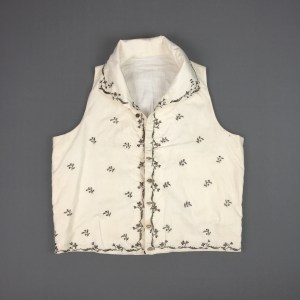
The c1800 waistcoat above is embroidered in silver, but it shows what the scale of the design should be. Also, the design virtually always (this is one of those times I’d normally say always, but there’s probably an exception out there) has borders around the edges and collar.

I am really annoyed by the boots. Maybe Mr. Parker has just come in from riding in this scene, but it’s the one full-length view I could find. The male characters seem to *always* wear boots. Regency-set adaptations never put men in what all the younger men should be wearing most of the time: pantaloons (snug) and trousers (slightly less so), not boots. Boots if you go riding, sometimes boots as morning dress, but NOT ALL THE DAMN TIME. Also, he should fire his bootmaker, because you could fit a small toddler between his leg and a cuff of one of those boots.
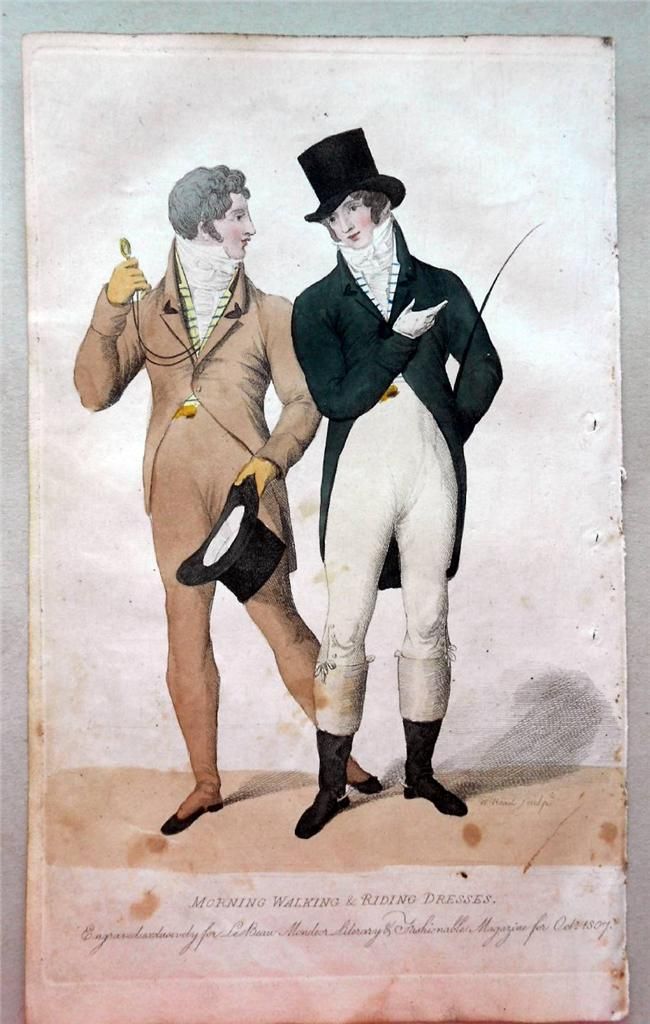
I’m not saying we should see the goofy-looking footie pyjamas, sorry, pantaloons with attached gaiters like those on the left here; but full-length leg coverings were common by now. Also please notice the boots: THEY FIT. As in: it would be hard to fit more than a finger between cuff and leg. This is why you have boot jacks. And valets.
The dresses are…fine. They’re standard-issue Austen-era high-waisted dresses, for the most part. I liked seeing Miss Lambe in a bib-front one in one scene.

Bib front dresses–a thoroughly modern term, we don’t know what they were called back then–are constructed with the front piece of the bodice sewn to the front flap of the skirt. You step into the dress, put your arms through the sleeves, the bodice lining has flaps to come over the bust, and then you pull up the front skirt flap, button the top corners of the bib front of the bodice, and use drawstrings to tie the skirt flap around your raised waist.

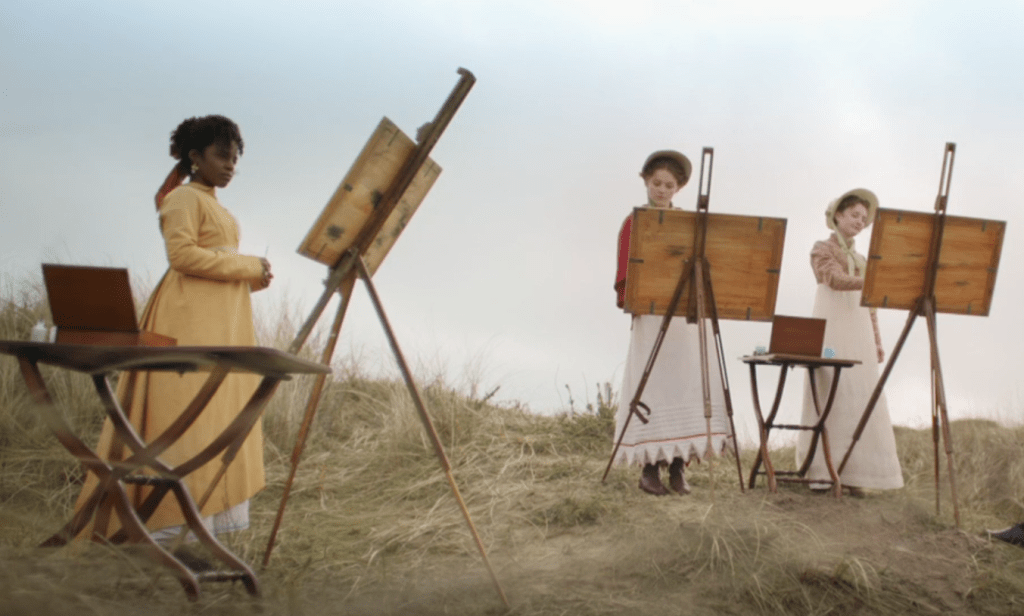
I liked this full view of the dresses and Miss Lambe’s yellow pelisse (coat). The pelisse’s graduated hem length is a very nice, unusual period touch that lifts this garment out of the generic regency style.
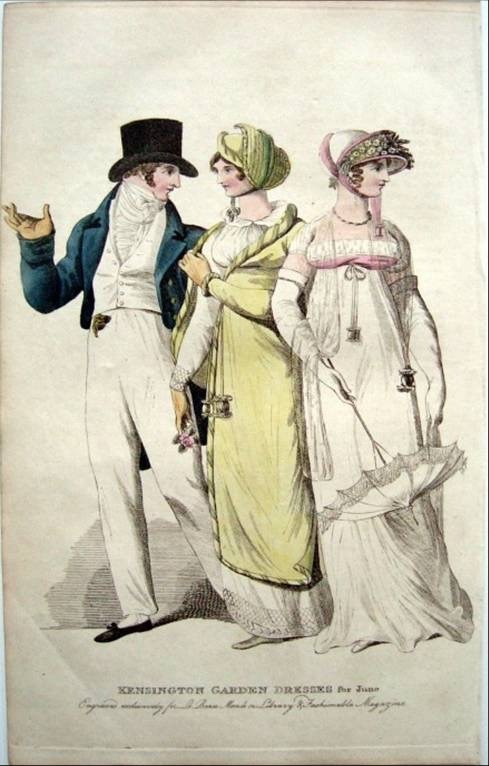
Here’s a bright yellow pelisse that does this a bit. And oh look, her companion is wearing TROUSERS with SHOES! no boots!
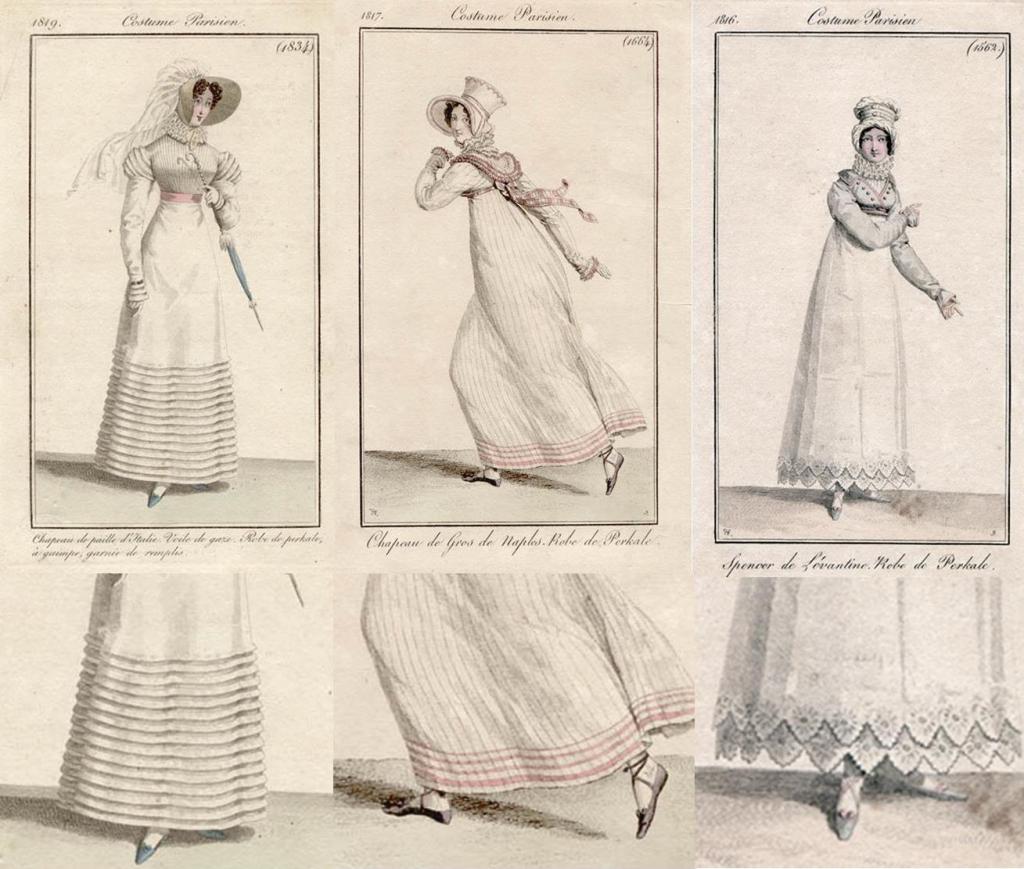
And the middle girl’s dress (sorry, I just can’t be bothered) combines three hem treatments from 1815-16: multiple decorative hem tucks (no they are not for growth, this period loved hem tucks), a colored band, and a deeply zig-zagged hem (called vandyked, after the painter Van Dyck whose portraits’ lace collars had similar edging; it’s part of the 1810s’ move from neoclassicism to other historical and “exotic” inspirations). You don’t usually see them combined this way, but it’s a really nice attention to period detail, so I’m cool with it.

Mrs. Parker has a nice dark dress seemingly made from a sari, which was a done thing back then although not as often as we see it done in the movies; but a good vintage sari will often have the right aesthetic for the early 1800s, which was using and copying many Indian textiles.

They’ve dressed Lady Denham in expensive but old-fashioned styles from the 18th century. It’s overdone in some scenes. Older women whose figures were not well suited to the radical new slim, high waist styles did hold on to 18th century stays (corsets), and seem to have worn the open robe over a petticoat (as above) long after the one-piece, same-fabric “round gown” mostly replaced it.

In the picture above, her waist is at least somewhat raised to a mid-1790s level. The 1807 edition of a comic poem The Bath Guide (below) depicts a woman wearing a round gown with a moderately raised waistline, but with a very 18th century looking bodice (and 1770s hair). Was this reporting fact, or was it an exaggeration to make a point about the older generation? I suspect there were some who dressed this way, so Lady D’s higher-waist gowns make some sense.

However, Lady Denham’s dresses are sometimes a full 30 to 50 years out of date, which is ridiculous. Her brown dress (below) has a stomacher (triangular panel in front, separate from the bodice which comes around only to about where the nipple is) which went out of style about 1770–its ribbons date it to the 1750s or 60s–and a natural waist level; the trim also dates to the 1760s or 70s. It’s one thing to be a little conservative because you’re the older generation. It’s another to be 40 years out of date.
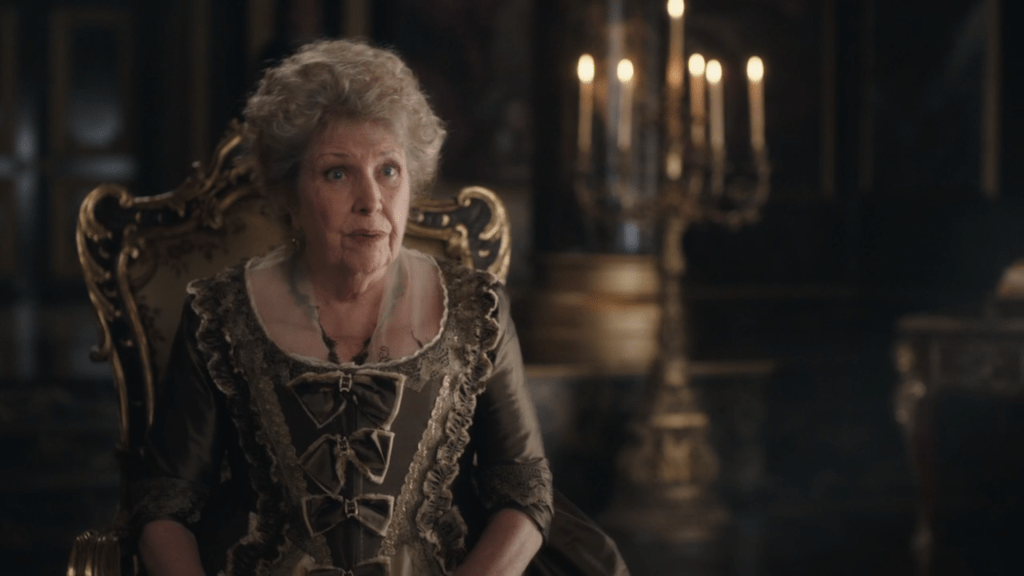
Compare her ruched (gathered) ruffle which undulates down the edge of the bodice and skirt, to this dress dated about 1760 in the Metropolitan Museum’s collection:

The ribbon bows on her stomacher are something we see in the 1750s and 1760s. Here’s Madame de Pompadour, Louis XV’s mistress painted in 1756 by Francois Boucher:

Charlotte’s clothes are nice–many of them are reused from earlier movies (this is done all the time; recycledmoviecostumes.com will show you all the movies where they’ve been spotted–I warn you, it’s a fabulous time-sucking rabbit hole!).

The blue spencer has also been worn in five productions between Persuasion and Sanditon; they are listed and pictured here: http://recycledmoviecostumes.com/regencyromantic024.html

This dress I did not recognize from Emma until I saw it on recycledmoviecostumes. It’s a really nice Regency dress: the cut, the weight and drape of the cotton, and best (and hardest and most elusive) of all, the PRINT are all perfect.
I’ve made a Postscript blog post on Sanditon showing more examples of reused costumes which I spotted, or found on the recycled site, if you’re interested.
Overall Charlotte seems to have rather too many spencers and pelisses, but maybe we are supposed to think her father has sent her some money for new clothes now that she’s been in Sanditon over a month? Or has Mrs. Parker given her some hand-me-downs?

In the last episode–four?–she was wearing a sort of jumper outfit (again, not a period term) of a white blouse under a sleeveless dress.

Austen adaptations LOVE jumpers. They look so nice and modern and “relatable.”
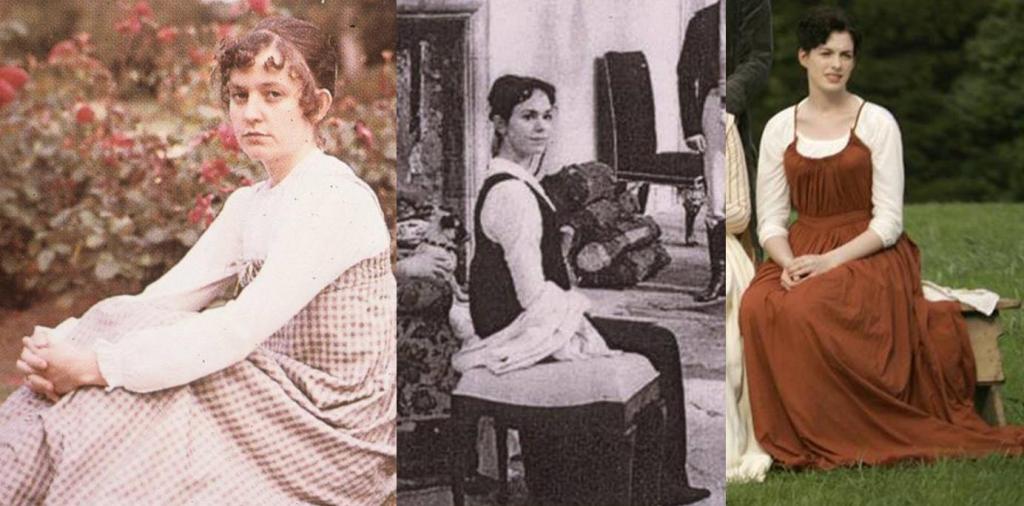
There are certainly period examples of this in fashion plates and in the sketchbook of Diana Sperling, a girl of Austen’s class and era, whose delightful watercolors of Regency-era life are collected in the book Mrs. Hurst Dancing. They were not nearly as prevalent as the movies suggest, but it’s an understandable choice.

My big, huge, enormous problem with Charlotte’s look–and it colors my feelings for the entire production–is her wretched, awful, non-period, horribly modern, ghastly, stupid HAIR. NOBODY wore her hair down around her shoulders like this. Maybe the very poorest, and mentally depraved. But there is NO good reason they should let the heroine look like this.

The Frock Flicks blog (I will never achieve their volume of posts on vast quantities of costume movies and telly adaptations, or their brilliant level of snark, so I recommend them to you if you want commentary on many, many other productions) calls this widespread tendency to leave period hair down “the great hairpin shortage,” but the real excuse is lazy pandering to audiences whom the director doesn’t trust to accept period styles. They think they have to make characters look “relatable” and not too “different.” Seems to me we all had no problem getting mentally and emotionally invested in all those earlier costume dramas, including the 1990s and 2000s Austen adaptations, where everyone’s hair was up properly.

I do not accept this pathetic excuse. Hair and makeup are always where period accuracy stumbles, because it’s impossible to get 100% into the past–the aesthetics of the period of production will sneak in somehow. Check out one of the many 1970s Austen adaptations, who did a decent job with costumes but couldn’t resist putting some 70s pouf in the hair.

But just leaving hair down is beyond the pale. It kicks me right straight out of Sanditon, whatever Andrew Davies is doing with making up a plot. I hope Miss Lambe gets to marry her hottie honey, but aside from that I really can’t be arsed to watch it closely enough to learn who everyone is and what they’re up to.
Love your post and agree with everything you say, and you left the best till last – that HAIR. Even today young women with long hair put it up in a simple topbun so much of the time so I dont give any credence to any of the designers’ “relatable” arguments.. I tend to think that fashion often reflects the practicalities of the time – and wearing hair down day after day over a dress collar, spencer or other neck garment would have been such a challenge in the days before shampoos, detergents and dry cleaning. Plus it looks wrong when the greek classical line was what was being imitated. Oh well at least that costuming faux pas is the least of the series’ problems – I have in fact given up on it after the first 3 episodes. One other thing that you mentioned and gave me a reminder (as trivia) – I grew up in Britain and the term for jumper is “pinafore dress” (or as part of a school uniform, a gym-slip but not worn in the gym – go figure). The term “jumper” in the UK always means a sweater or pullover. Just in case you are visiting and getting mixed messages from those Brits.
LikeLike
Excellent point about the clean hair. Certainly true about the greco-roman look they wanted. I do know about the change of terms re: jumpers. I guess I need to say that every time I use it–I keep getting told by kind Brits that my term means what we call a sweater–and I keep forgetting I might be read by an international audience. Thanks!
LikeLike
(This post may be posting twice since it seems to have asked me to re-enter a password so my apologies it this posts again.) I am forwarding a post I made to another blog on many of the same issues you have raised here. I don’t know if you have any expertise with regard to men’s shaving habits in the early 19thC but would love to know your thoughts: I watched the first 2 Sanditon segments and could not figure out why I was so annoyed with the portrayal of the men in the plot. I quipped to a friend that I thought they looked like misplaced Silicon Valley tech workers with the 5 o’clock shadow. To test my theory I visited the Yale Center for British Art and wandered through the wonderful collection. It was a slow visitor day (as in I was the only one in the Long Gallery) and I could not find one portrayal of a man with the now popular look. Even the guard, who asked me why I was going back and forth through the galleries, agreed that no matter which social class was portrayed (farmer, horse groomer, aristocrat) all were clean shaven even if they had sideburns, mustache etc. I know this is a nit but, since we have been spoiled by other directors who were so meticulous, I expected more. Thoughts?
LikeLike
Oh yes I didn’t even go there but oh please! It started with the 2005 Pride and Prejudice. Director said he wanted to show that they wouldnt’ have been perfectly coiffed and groomed all the time. Ok, I MIGHT buy that Mr Bennet, closeted at home in his study mostly, might skip a shave for a day or two, and that working classes might not shave so often either–maybe?? I have no research to back that up, but am only keeping my mind open to the possibility. BUT to go to the Assembly Rooms for a ball, all disheveled and unshaven? SO NOT OK. And hardly any facial hair ever in this era (Moustache, beard), either, which at least they generally get right.
LikeLike
Oh your instincts were, as you found, completely correct. Hair and makeup are, I think, the most frequent areas that are updated for contemporary taste. Main characters especially need to look attractive, and if stubble is “in,” they may decide to show it. (I think it’s dreadful in any age but that’s just me.) It’s just one more example of taking artistic license to appeal to modern eyes. I wonder if it’ll look terrible in 20 years when the style looks dated? (PS in 2005 Pride and Prejudice, they had stubble deliberately to show that in the country, men might not have been shaving every single day, it went with the less perfectly clean and pressed look and the women’s frowsy hair, and aside from stubble at the Assembly room ball, for which I think everyone would have shaved, I think it was a somewhat valid directorial choice.)
LikeLike
The whole production of Sanditon appears as if ITV did it as cheaply as possible, relying a lot on what they could get from Cosprop and a few new things. Save money on proper hairstyles, especially for Charlotte, who is in most scenes by keeping her hair down–the audience will find it more appealing anyway. ITV claims they didn’t get the viewership to do a Season 2, but I think they never intended to. Shows and series in modern dress can be done with less cost and potentially more profit, much as most American TV producers have gone to low-cost “reality shows.” HBO really wanted to go on with “Game of Thrones”, but the producers no longer wanted to spend the money, especially on the main cast members salaries–naturally the producers want as much money as possible rolling into their bank accounts. Eagerly awaiting “Emma.”
LikeLike
Cosprop! Why could I not think of that name this morning (um, no coffee yet?). Yes, we in USA tend to assume these are all lavish BBC programs (or programmes lol), but ITV does a lot of them and it’s a bit akin to having the WB or some such channel, in charge. I don’t mind the recycling as such–if chosen well. I quite enjoy catching them, actually!
LikeLike
Totally agree about the hair! Ugh! Was it episode 2 where Charlotte’s hair is finally up for dance? I thought, okay, someone has realized the error and the hair issue has been fixed. And, then down it came again! Oh, well. I didn’t realize how often costumes are reused. Very interesting! Thank you for your insights. I thought I was just being picky. 🙂
LikeLike
Well, it’s ok to be picky! We all can be picky at our chosen level. I understand the reasons for many of the choices and accept some and reject others–like hair down. Total lack of respect for mores of the time pisses me off.
LikeLike
Actually, it was customary for ladies to leave their hair loose at seaside resorts. John Byng talks about this in his travels book when he’s in Weymouth. It was too much trouble to keep hair up in the proper way because of the wind, plus sea-bathing, of course. So I wasn’t bothered by the hair at all when they were on the beach or within wind areas. In the evening, of course, they should have been wearing their hair up, and now I can’t remember if they did or not!
LikeLiked by 1 person
I can’t believe they just let it completely down like this. If you have a bonnet on as of course you did, it couldn’t have been THAT hard to keep it up even if it got untidy. Wind doesn’t reach under a bonnet and take out hair combs. I’m intrigued by this source however and thank you for directing me to it. Still say it’s no excuse for Charlottes hair (and why was everyone else’s up then? I think it gives too much credit to designer to suggest this was a choice based on research.).
LikeLike
Actually, on reviewing Byng’s Rides Round Britain, I realise it’s actually not in there. I will have to dig out the source which I now can’t remember. I’ve set several stories in Weymouth, hence having that piece of information in my head. I probably got it from Louise Allen’s excellent book on seaside resorts, The Georgian Seaside, and I’ve no doubt she listed her source there.
LikeLike
The loose, messy hair bothered me so much I quit watching the series. I recently tried to watch an episode from the second season only to be “gobsmacked” that Charlotte was not wearing gloves at the ball. She was actually touching bare skin with her partner. She also runs around unchaperoned… hmmm
LikeLike
While I know that it is technically not period appropriate for her to leave her hair down, I also HATED how severe many of the updos were in Colin Firth P&P, the 2007 Persuasion, and others. I also hated Keira Knightly’s hair/bad wig in her P&P version. I thought their hair looked dirty and unflattering. To me, ugly hair is much more distracting. The only movie I wasn’t turned off by hair was Emma (1996). If Charlotte’s the kind of girl that would be out shooting rabbits in the countryside and rescuing people from wrecked carriages, I can get on board with her not being a girl who gave a fig about messing with her hair on a daily basis. Her character is more girl next door/tom boy and I think it fits her. It always looks period appropriate for formal functions and for me, that’s what counts. Enjoy your blog!
LikeLike
I hear you on P&P95 and 05. 05 director said he was trying to show they didn’t all have maids to help them look perfectly coiffed all day, but went too far in opposite direction (also, DRAB clothes, for pete’s sake they aren’t peasants, also BANGS, also poorly fitting because apparently Keira had body issues oh please). But with respect, I disagree about Charlotte, no matter how outdoorsy, I don’t care if she didn’t give a fig personally, you didn’t just get to decide as a 16-17 year old or whatever age really, to reject societal norms and rules. We can’t apply today’s acceptance of “you do you” individualism to back then. Rules were rules and you were absolutely judged to be respectable and acceptable based on your following them. She could not and would not have just decided “not to give a fig.” I still really can’t stand that they abandon the period mores this way. But I get that you as a modern viewer are willing to accept that and we all get to accept deviations from accuracy as we choose. And clearly lots of people are ok with it, as the series seems to be quite popular. That damn hair kicks me almost entirely out of the whole series, I’m afraid. (And usually I can accept a lot of tinkering with nitpicking details of this or that fact or garment.) But as I say–to each our own level of nitpicking.
LikeLiked by 1 person
Sometimes actreses get fussy about wearing uncomfortable costumes I hear the BBC has banned corsets. Great its impossible to wear historical costumes without corsets. You just need expert wardrobe staff to help actreses wear corsets. As a wardrobe mistress and costume maker believe me you need to educate the actreses how to wear dresses sit walk .
Just as brides these days need coaching on how to wear and wedding dress and go to the toilet.
Hair and makeup is essential for a complete look. Social history needs to be studied.
LikeLike